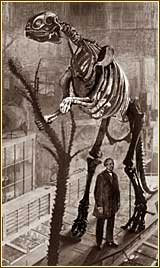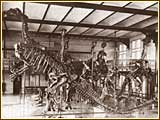Every dinosaur skeleton mounted in every museum in the world traces its roots to Haddonfield's

|
|
Academy of Natural Sciences |
|
|
Hadrosaurus foulkii was the first dinosaur skeleton ever put on public display. Sculptor Waterhouse Hawkins stands near the creature's massive leg bones. Take a VIDEO TOUR of the current exhibit at the Academy of Natural Sciences in Philadelphia.
|
|
Hadrosaurus foulkii. Along with being the first reasonably intact dinosaur skeleton ever found, the New Jersey fossil was also the first dinosaur skeleton ever put on public display.
Pioneers
The very concept of reassembling and erecting the massive bones of a dinosaur in a life-like posture as a museum exhibit was pioneered at Philadelphia's Academy of Natural Sciences by a team composed of Dr. Joseph Leidy, Edward Drinker Cope and Waterhouse Hawkins. Hawkins, a sculptor from London, was the primary artist and engineer on the project. Leidy, director of the Academy, was the scientist who documented and interpreted the Hadrosaurus foulkii find. Cope, a professor of zoology, was the Academy's curator.
In 1868, when the completed project was unveiled, it created a sensation for the public and scientific community. Crowds swelled at the Academy -- providing the first hard evidence that, aside from their scientific significance, dinosaurs could also be great revenue producers for museums. Scientists and museum curators from across North American and Europe flocked to the exhibit.
Hadrosaurus copies
In creating the Hadrosaurus foulkii mount, Leidy, Cope and Hawkins had decided not to use the actual bones, but devise a system for making molds of the bones from which plaster replicas could be cast. The molds allowed Hawkins to clone the display specimen.
One of the first duplicates -- the one shown in the photo above -- was created for display in a planned fossil exhibit in New York's Central Park. But shortly after its completiton in 1871, it was destroyed by the henchmen of "Boss" Tweed who smashed the bones apart and heaved them into a nearby lake. Tweed was the corrupt and ruthless backroom political czar of post-Civil War New York City who demanded payoffs and kickbacks from nearly everyone involved in public entertainments and other business pursuits.
1876 Centennial
In 1876, when crowds from around the world surged into the grand halls of the U.S. Centennial Exhibition in Philadelphia's Fairmount

|
|
Institut Royal des Sciences Naturelles |
|
|
Hadrosaurus foulkii was the only dinosaur on public display anywhere in the world until 1883 when these iguanadont fossils were put on exhibit in Brussels.
|
|
Park, one of the most awesome exhibits they encountered was the towering skeleton of Hadrosaurus foulkii. An estimated 10 million people attended the Exhibition, which also featured the torch from the not-yet-completed Statue of Liberty.
In 1879 a copy of the Hadrosaurus foulkii mount was constructed and shipped to the Royal Scottish Museum in Edinburgh, Scotland, where it became the first dinosaur mount ever displayed in Europe.
Downtown Washington, D.C.
The Smithsonian Institution acquired a copy and erected it outside its main building, making Hadrosaurus foulkii a landmark of the nation's capital and an icon of the facility's dedication to the fossil sciences. Years later, this display succumbed to weather and wear and had to be removed for safety reasons.
Yet another went to Princeton University for display in its historic Nassau Hall.
For 15 years after it went public in 1868, Hadrosaurus foulkii remained the only dinosaur skeleton on display anywhere in the world. Its solitary reign as the dinosaur fossil came to an end in 1883 when the skeletons of Iguanodonts excavated from a Belgian coal mine went on display in Brussels.
Modern museums
By the turn of the twentieth century, the activities that began with the discovery, excavation and display of the Haddonfield dinosaur had become a broadly organized modern science as well as an industry that grew larger each year. Hundreds of major dinosaur skeletons were found in the final decades of the 1800s -- many of them animals of a size and ferocity far beyond that of the plant-eating Hadrosaurus. These new specimens began to fill museum halls built specifically for the dramatic display of the prehistoric monsters that became the biggest attractions in natural science museums.
Today, Hadrosaurus foulkii remains a keystone exhibit in the dinosaur halls of Philadelphia's Academy of Natural Sciences, the facility where the public first encountered the awesome reality of an actual dinosaur up close and personal 134 years ago. -- Hoag Levins
|







